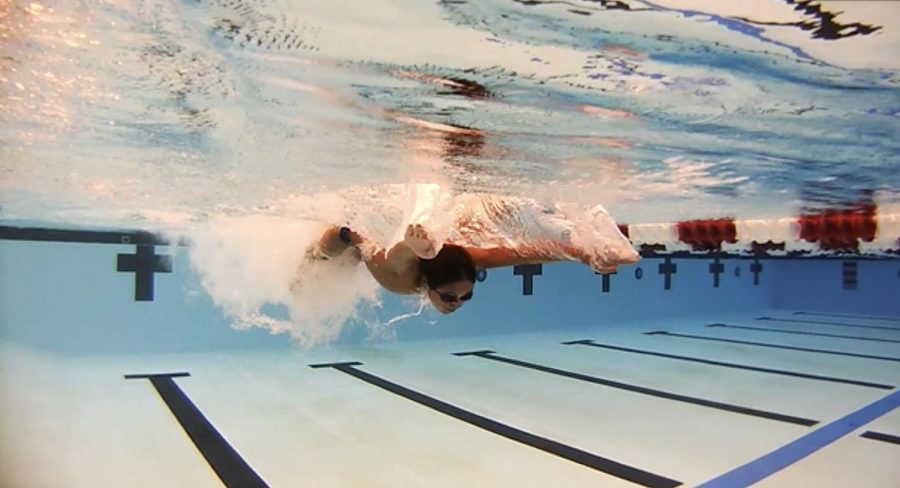Swimming in water and work
Sophomore Evan Chien sprints a butterfly lap along the black lines spread out across the pool floor during training. (Photo: Ethan Chien)
May 27, 2023
A black line is all you will see for hours on end. Back and forth, until you memorize the number of tiles there are. That’s the basis of swimming, but people don’t go to pools for the excitement of befriending the floor.
In competitive swimming, the thousands of hours spent in the water are not only to build endurance but more importantly to perfect technique—reducing drag and increasing strength. Swimming’s reliance on incredibly intricate techniques truly defines the difference between the good and the great. The smallest details can make or break a race, and in the highest level of competition, wearing something as minor as a necklace into the pool can be what determines first and second place.
These are among the things that club swimming brings into a high schooler’s life, making the balance between school and sports a daily challenge. High school sports are built around your education, but my club didn’t make that distinction. Though the time it takes makes every day a struggle to balance, swimming has taught me lessons I wouldn’t trade away.
But as high school gets into full swing, there’s only ever more and more work. Club swimming does not get less and less to match. For myself, there’s a lot of other things I could be doing from studying tests to getting job experience. This mounting pressure constantly begs the question: Is it worth it?
I’ve been a competitive swimmer since I was seven years old. In recent years, I would attend practice eight times a week, an hour in the mornings and three hours in the afternoons, year-round, rain or shine. Even during winter break, our coach’s thoughtful gift to us was two weeks of absolute waterlogged hell. The thought of miles and miles of training daily, until we were dead both inside and out, on day one, loomed over our winter break. Oh, what a wonderful time of the year.
However, through all the challenges brought intentionally by our coach and unexpectedly from the weather, I have learned life lessons in strength and perseverance. From training in pouring rain to driving in three feet of visibility to get to Nevada to race, these experiences taught me to focus on the things within my grasp.
Though the weather might not have stopped us from training, it was hard to work around. It almost seemed like whoever designed the Rinconada pool aimed to make life difficult in the rain. Piles of gear got stacked up under the measly one-foot-wide overhangs surrounding the facility that provided the only shelter to keep them from being as cold and soggy as us. During swimming, rain would fill your mouth every time you came up for a breath. Waves from strong winds would haul you backward. But in the end, pushing through the miseries of training in the harsh weather and the exhaustion that came with it helped me develop mental fortitude. I was conditioned against these challenges, letting me perform no matter if the sun was shining. I couldn’t change what was around me, and my mindset was the only thing in my control.
While “mild” weather like rain might not stop me from racing, dial the severity to 11 and there might not be an option to compete. I clearly remember the bus swaying left and right as we drove through a heavy blizzard in the Nevada Mountains trying to reach Reno for a state-wide competition. My friends had decided not to go for fear of the weather. It was hard to see past three feet. What’s worse than driving next to a cliff in a blizzard when you’re terrified of heights like me?
On another occasion, a massive storm rolled in as we prepared to race at the Burlingame Aquatic Center. The rain flooded the drains, and the pool deck simply became a part of the pool. Eventually, the meet had to end early, and though I was disappointed that I couldn’t swim my favorite event (the 100 breaststroke), I knew I had done the best I could before the storm rolled in. Through these experiences, I learned that some things couldn’t be prepared for. There was no guarantee that there would be a second chance, so I should do everything the best I could the first time around.
Despite the tough lessons I’ve taken from swimming, at the end of the day, I find myself still at that same old pool. The grueling routine of 4 a.m. practices and summer break intensives take a toll, but the small memories made out of the monotony are what draw me back, day after day, rain or shine. Trying to get up at 4 a.m. every other day for an hour of training is quite the feat in itself. Week after week, month after month, I found myself falling into the rhythm.
Then there’s that one day when our coach announced morning practice the next day was canceled. It was like the day after school’s out for summer break. I woke up according to my internal schedule, and while preparing to pack up my swim gear, I suddenly remembered: no need! Jumping back into bed was one of the best feelings ever. Whether it’s sleeping through a canceled practice, finally improving on my sprint freestyle, or accomplishing a long-distance event, those were some of the small highlights that made me feel great and hooked me back to the pool.
Unfortunately, everything comes with a price.
In high school, the struggle brought by the time commitment to swimming truly makes its grand entrance. Going home at 9 p.m. after practice and still having homework and chores is a mental workout in itself. Guess what else is on the horizon? College recruitment. If you were not already one of the fastest on the team, your pressure to make the cut is drastically increasing day by day. Swimming has no linear improvement curve; some swimmers go from placing last in every meet to being one of the best in the state within the four years of high school. (Believe me, I’ve seen it.) However, there’s no guarantee that you’ll see a breakthrough like that, and it makes everything a gamble.
The pressure really mounts in sophomore year, with junior year looming ahead. As junior year is reputedly the hardest year in high school, that time committed to swimming might decide between an A and a B in each class. I found myself constantly debating between whether I should stick to a sport I love or focus on school. I’ve been swimming in this circle of thoughts for nearly two years. In the end, due to the amount of schoolwork I have from taking eight classes this year, I decided to quit club swimming and only do high school.
For those who are willing to make the time commitment, the rewards of swimming can be immense. Not only is swimming an excellent form of exercise, but it can also be a source of stress relief. Like most other sports, swimming helps make new friendships and build a community. The countless hours of training, pushing ourselves to the limit and spending numerous weekends at meets helped build a unique connection that bonds club teams like family. My group of friends are the people I’ve spent years training day in and day out with. Though my personal struggle between swimming and education may not have worked out, the lessons learned and friends that came out of it make everything worthwhile. While our sport consists of looking at the same black line and pushing off the same bland wall for hours, at least we’re not doing it alone.



